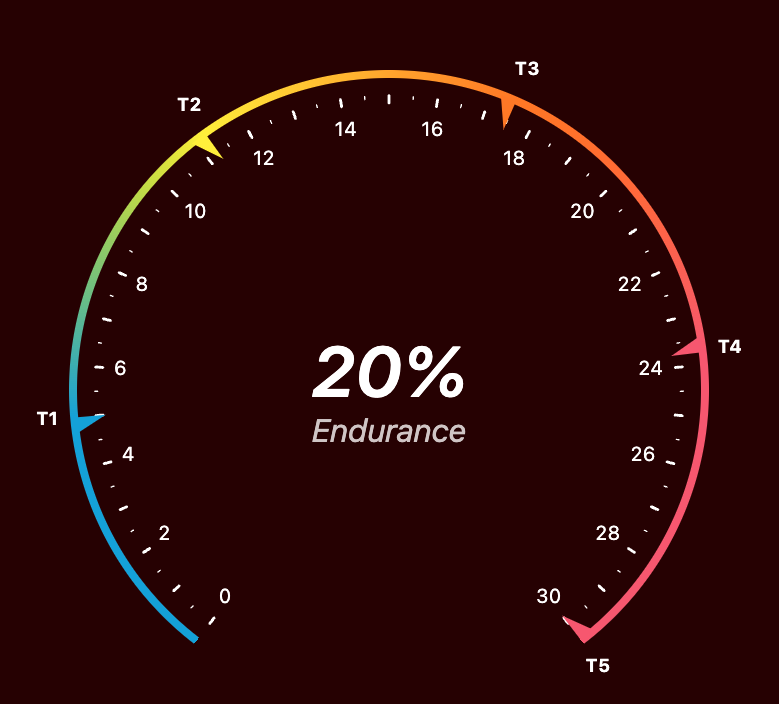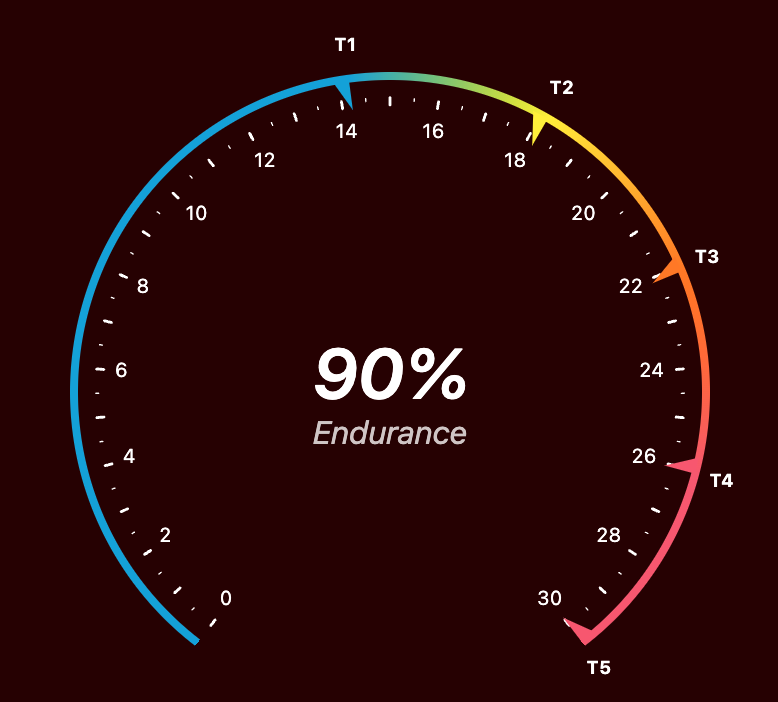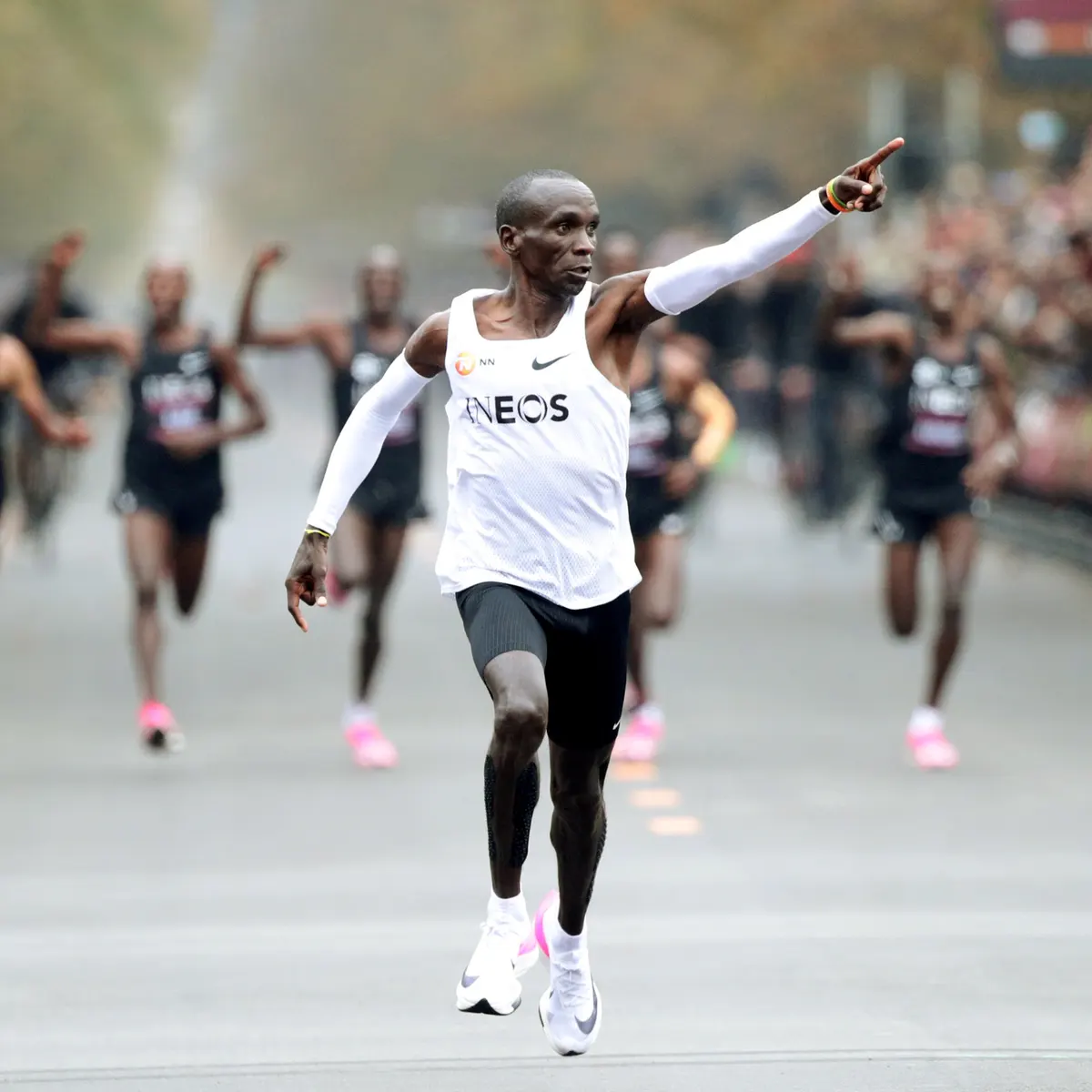The Discovery of Endurance
If you are reading this blog then surely you must have witnessed Eliud Kipchoge's epic breaking of the 2-hour barrier in the marathon in Vienna in 2019. Crossing the line in 1:59:40 was an incredible feat and one of the best individual performances in sports history. Clearly Kipchoge possesses unique abilities for distance running, such as superior aerobic endurance. But just how high is Kipchoge's endurance level? What is endurance, for that matter?
The Breaking2 study
Well, in 2017 Kipchoge was recruited into the selection camp for Nike's first Breaking 2 race later that year, where he came very close through finishing in 2:00:25. In this camp a large group of elite endurance runners underwent extensive laboratory testing with measurements of VO2max, lactate and running economy.
 Eliud Kipchoge undergoing lab tests in preparation for NIKE Breaking2.
Eliud Kipchoge undergoing lab tests in preparation for NIKE Breaking2.
When the results came in, the researchers were both surprised and somewhat disappointed! The running economy was in line with other elite runners (average 189 ml/kg/km), but the average VO2max was only 71 ml/kg/min (62-84 ml/kg/min), which was much lower than expected from the best endurance runners in the world (Jones et al. 2021).
Incidentally, 71 ml/kg/min is the exact same VO2max as I mustered in VO2max tests during my student years. The only difference is that I was a three-hour marathoner at the time, a full hour slower than EK! Clearly, my decent VO2max value did not translate well into the marathon.
The missing link
In this study, the classic model for marathon performance failed to predict the performance of the runners. The classic model includes three main variables i.e., VO2max, running economy and the lactate threshold speed, but the researchers concluded that a fourth variable, describing fatigue resistance, was missing to complete the model.
This in a way sums up the state-of-the-art in exercise physiology after 80 years and thousands of laboratory studies. Millions of people (you do the math!) have been driven to exhaustion on treadmills and stationary bikes but there still exists no direct measure of aerobic endurance! Despite seemingly endless studies showing that VO2max correlates poorly with endurance performance, the field of exercise science is still obsessed with VO2max! VO2max is pushed by fitness brands and displayed by fitness trackers as a measure of cardiorespiratory fitness.
It feels a bit awkward to blow one's own horn but we at Driftline now feel a bit like Kipchoge when he came striding down the homestretch in Vienna, knowing he was about to break the 2-hour barrier. We too have been racing for a long time, and now we are about to present our biggest discovery to the world!
We proudly claim to have discovered the missing link of exercise physiology. We have simply named it:
E (Endurance) - the first true measure of aerobic endurance.*
 Endurance explained through the alignment of exercise thresholds on a speedometer.
Endurance explained through the alignment of exercise thresholds on a speedometer.
The speedometer shows the five exercise thresholds, in accordance with Driftline's exercise threshold system. The thresholds are evenly spaced, with the T5 threshold fixed as the maximum speed. The relative alignment of the T1 threshold determines the aerobic endurance, and it is therefore aptly named Endurance threshold. The T1 threshold can be aligned anywhere between zero and 50% of the T5 max speed threshold. In the particular example above, the T1 threshold equals about 1/6th of the max speed and the thresholds are spaced relatively far apart. This relatively distal threshold alignment translates as 20% Endurance, which might be characteristic for a sprinter type runner.
The Endurance parameter
As explained in our last science blog (Your True Exercise Thresholds), human muscle consists of three major types of muscle fibers, i.e., 1) slow oxidative fibers, 2) fast oxidative and glycolytic fibers, and 3) fast glycolytic fibers. With increasing exercise intensity, the working muscles recruit progressively faster fibers and transitions in fiber recruitment are reflected in five evenly spaced exercise thresholds (T1 - T5).
As explained above, the new Endurance parameter reflects the alignment of the exercise thresholds and scales between 0 - 100%. The graph below shows an example of a high endurance athlete with closely aligned thresholds and high aerobic endurance.
 The threshold alignment of a runner possessing 90% endurance.
The threshold alignment of a runner possessing 90% endurance.
In the above example, the T1 threshold equals almost half the maximum speed and the thresholds are closely aligned. This relatively proximal threshold alignment translates as 90% Endurance, which may be characteristic for an advanced endurance runner. Due to a high proportion of slow, aerobic muscle fibers and relatively high oxidative power, this runner will get good mileage from limited glucose stores and produce competitive race times over long distances (see details below).
In our modest opinion, the discovery of Endurance is poised to become an important milestone in exercise physiology.
What exactly is Endurance?
OK, a little exercise physiology 101. The human body has three energy systems:
- The phosphagen system (anaerobic).
- The glycolytic energy system (anaerobic).
- The oxidative energy system (aerobic).
The anaerobic systems (1 and 2) use sugars (glucose) as fuel, while the oxidative system (3) uses mainly glucose but also fat (triglycerides) to a lesser extent. The anaerobic systems are more powerful, but the oxidative system is the most efficient system by far (more energy from each molecule of glucose). The slow aerobic, non-glycolytic fibers only use the effective oxidative system and are therefore less powerful but more efficient than the glycolytic fast fibers.
Endurance reflects mileage.
The glucose stores in muscles and liver are limited but similar in all athletes, regardless of endurance. Your mileage (the distance you can cover on your full tank of glucose) depends on the preservation of your glucose stores.
A runner with a high proportion of slow, aerobic fibers has a relatively high combined oxidative power (aerobic) and as a result, requires relatively little additional glycolytic power (anaerobic) to power muscle activity at a given intensity. A low-endurance runner with relatively few slow fibers, must recruit the glycolytic fibers at a relatively lower intensity and thus the glucose stores will be depleted much sooner. The high-endurance runner will get better mileage from the glucose stores and produce better race times over long distances. So, in a nutshell:
Endurance is fuel preservation through muscle efficiency.
Car analogy anyone?
If you're still confused, we can always go for a simplified car analogy. Take two hybrid cars with an electric motor (oxidative) and a gasoline combustion engine (glycolytic). Car A can go to 40 mph on the electric motor and has a top speed of 120 mph on both engines (using both at the same time). Car B can go to 50 mph on the electric motor and has a top speed of 100 mph on both engines. Both cars have a 20-gallon tank to fuel the combustion engine. They now enter a race for most distance covered on a full tank at a fixed speed of 60 mph. The batteries are continuously charged. Car A uses more fuel at this speed and runs out after 300 miles, while car B runs out after 500 miles. Car B won the distance race because it had a more powerful electric motor, thus sparing fuel for the combustion engine. In human running terms, car B had the greater endurance.
 Endurance reflects mileage.
Endurance reflects mileage.
Is there really an upper limit to endurance?
World-renowned distance running coach Renato Canova advocates that distance athletes need to build up their aerobic house for about ten years to reach their full potential. When the aerobic house is fully built, the athlete will gain no further benefit from extreme running mileage and some more specialized training is required to improve performance. Canova's training philosophy thus agrees nicely with Driftline's concept of maximized endurance. Driftline's exercise threshold system (ETS) assumes that due to constraints within the muscle, there is a fixed upper limit to endurance. This is where the slow fiber ratio is maximized, and thresholds are in proximal alignment (T1 equals half of T5). Conversely, endurance will be minimized where the slow fiber ratio is minimized, and thresholds are in distal alignment (T1 equals 0).
Is endurance trainable?
Driftline's testing of hundreds of men and women from a wide range in age and physical activity, has shown a wide range in endurance, from about 10% in some sedentary people or sprinter types, to upwards of 100% for international level marathon runners. Most of the endurance athletes tested have, however, been shown to have endurance scores in the range of 50-80%. The endurance score has also been shown to be largely trainable, since longitudinal testing of marathon runners has shown a steady increase in endurance from about 60% at teen age, up to more than 95% at an age of about 25-28 years.
 Endurance is trainable.
Endurance is trainable.
The training effect is caused by muscle adaptation to endurance exercise, whereby the so-called hybrid fibers from the intermediate layers are transformed to slower and more oxidative fibers (see Moreillon et al. 2019). This highlights the other side of the coin for endurance training, namely the loss of maximum speed associated with the transition from fast to slow typology. The best endurance runners are those who can increase their endurance, while minimizing the unavoidable, concomitant loss of maximum speed.
The problem with VO2max
The field of exercise science has long been obsessed with using maximum oxygen uptake (VO2max) as a proxy for cardiorespiratory fitness (CRF). Traditionally, VO2max (liters of oxygen delivered per minute) is simply scaled by bodyweight, that is divided by bodyweight including the weight of fat and bones. This kind of direct scaling is debatable and studies (Tompuri et al. 2015) have shown that VO2max scales much better with lean mass (not including fat). Of course, it would make even more sense to scale VO2max only by the metabolically active tissues, like muscles and organs, but this kind of metabolic scaling is rarely done in scientific studies. Metabolic scaling of VO2max would be a more realistic measure of CRF, with elite endurance athletes producing relatively higher values due to their relatively lower muscle mass. With metabolic scaling, female athletes would also get a fair and unbiased VO2max score.
We are not debunking VO2max per se, it is a valid measure of CRF, but the current scaling is biased and unacceptable. We predict that the current methodology of maximum effort lab-testing of the biased VO2max will soon become obsolete with the advent of the new submaximal Driftline fitness analytics.
How can we measure our endurance?
How do we go about measuring our endurance? Do we need to scan our muscles or even take painful and invasive biopsies? No, we don't!
Thanks to new discoveries it now only takes a brisk walk or easy run to measure endurance. Driftline's new smartphone app, Indurance, analyses heart rate data from fitness trackers or smartwatches and not only measures endurance, but also numerous other fitness parameters such as maximum speed, maximum heart rate and speed thresholds. Indurance is also an advanced training app for runners, offering interactive training programs based on constantly updated user analysis.
Can we now finally measure Kipchoge's endurance?
So, are we now able to answer that initial question about Eliud Kipchoge's endurance? Yes, we are! By feeding his phenomenal race times from different distances into the Indurance time machine we can provide a close proximation. The time machine indicates that in 2019, Kipchoge's endurance was about 99-100%, meaning that his aerobic capacity was very close to maximized.
However, many other elite marathon runners also seem to possess close to 100% endurance. What really makes Eliud Kipchoge the world's best endurance runner is his amazing maximum speed of close to 33 kph. This unique combination of speed and endurance is what made it possible for Eliud Kipchoge to break the 2-hour barrier in the marathon.
 One of the best distance runners of all time.
One of the best distance runners of all time.
The bottom line
Now, we may not all have been born with extra-ordinary physical capabilities or be inclined to break superhuman performance barriers, but we can always try to break our own barriers, right? By adopting and using these new analytics, anyone can gain a better understanding of their own unique physiology and use that new knowledge to reach their own personal health- and fitness goals.
We at Driftline are making the case that our new Endurance parameter indeed is the mysterious missing link of exercise physiology, sought after by exercise scientists. The new parameter adds the missing fourth variable, describing fatigue resistance, to the classic model for endurance performance. Endurance may be one of the most important health- and fitness parameters ever discovered, so the discovery of Endurance may prove to be an important milestone in the study of human physiology.